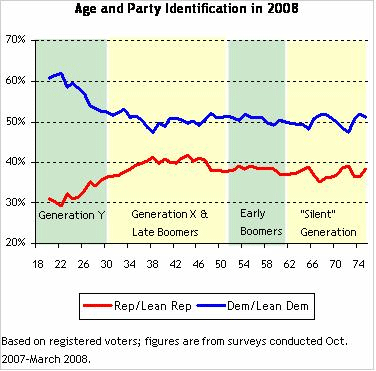by Andrew Kohut, President, Pew Research Center
Special to the New York Times
The phrase “generation gap” came into vogue in the 1960s as a way of describing the wide gulf in values, beliefs and lifestyles that emerged between baby boomers and their parents and grandparents. Indeed, this difference between younger and older people played out sometimes turbulently in the ’60s in virtually all aspects of life, including the ballot box. Unlike in previous elections, from 1968 to 1980 young voters gave much stronger support to Democratic presidential candidates than did their elders.

But by 1984 those baby boomers were not so young and their ideas were not so different. And until very recently, a political generation gap between younger and older voters was not so great.
The national elections in 2004 and 2006 saw younger people casting more votes for Democratic candidates than did older voters. During the last two years, polls have shown voters ages 18 to 29 aligning themselves with the Democratic Party in great numbers. Indeed, they have found their chosen candidate in Barack Obama, who has carried the youth vote in 28 of 32 primary elections where exit polls were taken.
Interestingly, older voters — many of whom supported Democrats over the years — seem reluctant to support Obama. Hillary Clinton has carried the vote of people over 65 in 26 primary elections. And looking forward to the general election, the national polls now show John McCain running better against Obama among this older age group — as well as among middle-aged voters and younger voters.
Furthermore, while Barack Obama’s appeal to young people coincides with their greater inclination to support Democrats, older voters do not show a greater allegiance to the Republican Party that might explain their current voting intentions.


